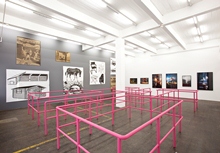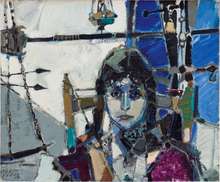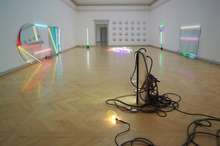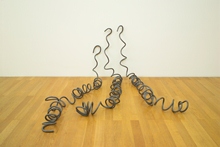Donations and new acquisitions
In years past, the collection of the Kunstmuseum St.Gallen has increased its assets decisively through eminent donations, and the Museum has been able to put together a broad field of dedicated collections. In this way, international art has networked with local creation right from the very start. The former shapes the art-historical context within which art from eastern Switzerland is meaningfully embedded.
New acquisitions
In the area of international art, outstanding works are acquired in order to set deliberate accents in the formation of the collection profile, and also to mark the trail of our own exhibition activity. Seminal works by Franz Ackermann (*1963) and Anthony McCall (*1946) are examples of new contemporary additions.
Franz Ackermann, born in Neumarkt St.Veit in 1963 and currently living in Berlin, created the impressive installation Facing Sunrise for the Biennale von Lyon. Arranged as a «space within a space,» a drawing spreads out over the four walls with inserted black-and-white photographs containing, among other things, details of the Palast der Republik in Berlin shortly before its controversial demolition in 2006. By means of a cube of massive metal grating set up in the middle, seeing becomes a physical tour around the center of the work, which cannot be entered. Even when one seems to recognize particular elements, such as abstract city maps or cryptic graphic signs, the view oscillates between close-up and distant view, between micro- and macrocosm, between what is actually seen and conceptually constructed—however, for the most part, a visual dizziness remains as a concise metaphor for the world of today.
Line Describing a Cone (1973) by Anthony McCall is a seminal work of light art with which the artist, born in the vicinity of London in 1945 and currently living in New York, influenced art and film history. In a darkened space, through a fine veil of mist one sees how from one point, a sickle forms, grows ever larger, and after thirty minutes, becomes a full circle. The light of the film projector simultaneously creates the form of a cone, a temporary sculpture, as it were. Line Describing a Cone is also a cinematic experience, «It is the first film to exist in real, three-dimensional space» (McCall), whereby the artist is considered one of the pioneers of Expanded Cinema of the 1970s. However, the impressive work mainly offers a spatial experience that seizes beholders directly, and actively integrates them as actors who have entered the field of projection.
Contemporary art from eastern Switzerland

Traditionally, the City and Canton of St. Gallen have acquired significant works by artists from eastern Switzerland from the Heimspiel exhibition for the Kunstmuseum St. Gallen. The Kunstmuseum thereby fulfills its mission of securing significant work groups by important artists from the region.
Heimspiel 2012 again provided the opportunity to acquire outstanding works for the Kunstmusem’s collection with means from the lottery fund of the Canton of St. Gallen, among others, following acquisitions for the collection in 2009 of works by Alex Hanimann (*1955), Karin Bühler (*1974), Patrick Rohner (*1959), and Kilian Rüthemann (*1979). The Kunstmuseum has thus been able to secure a five-part series by Karin Schwarzbek (*1969), an installation by Kilian Rüthemann (*1979) and Marcus Geiger (*1957), and a video by Sebastian Stadler (*1988).
The series by Karin Schwarzbek Untitled (2012) is representative of her artistic oeuvre, which searches for codes for bodies’ collective experience, moving in spheres of light and dark, depth and surface. Schwarzbek’s canvas paintings are the result of a long-term occupation with the dissolution and re-discovery of the human body. The works are practically free of traces of the representational, and comprise mainly flat layers, maintained in a gradated palette. Minimal overtones and differentiations give occasional hints of a face or of body parts.
The spectacular installation Linger! (2012) by Kilian Rüthemann has likewise been included in the collection of the Kunstmuseum. The work is composed of four sheet metal volumes placed on top of one another, which in their form not only resemble matrasses, but also in their statics behave like mattresses. Nonetheless, they are rigid. In the exhibition, lying over the stairway in the representative, neoclassicist foyer of the Kunstmuseum, the work forms a powerful gesture; whereas the mattress-resemblance evokes softness and lightness, here it is confronted with the conventional hardness of the material, and the act of bending it into shape.
Kilian Rüthemann always confronts the given situation of an exhibition site, examines its spatial qualities, and through precise interventions, reaches into the available architectural structure.
What seems to be a common use article, like three brooms with curved handles, Untitled (1997) by Marcus Geiger, arose from an elaborate production and can be understood in the museum as a captious commentary. Marcus Geiger, who works with a conceptual approach, interrogates the categories and concepts of art, provocatively questions them, and undermines the mechanisms of the operating system. With irony, he selects materials that stir associations with domestic comfort.
Donations from the estates of artists from eastern Switzerland
With a brilliant donation of work by Walter Burger (1923–2010), Maria Burger, the wife of the artist recalls his close association with the Kunstmuseum and Kunstverein. The works comprehensively illustrate Walter Burger’s oeuvre and form an arc from the early oil paintings through the sculptures of the 1960s and 1970s to the late drawings and acrylic paintings. Together with models and drawings, which the Museum additionally acquired, the gift expands the existing work inventory to a substantial collection block, allowing the traveling exhibition, which took place in 2011, «Walter Burger und Künstlerfreunde,» to be mounted, for the most part, with these works.
A comprehensive work group of twenty-eight paintings by Ella Bürgin (1883–1965) was added to the collection as a gift from Momino Schiess. From the estate of the artist’s daughter, the Kunstmuseum was able to additionally accept a bundle of paintings, drawings, and prints by August Wanner (1886–1970). This significantly expands the comprehensive and representative bundle of Ferdinand Gehr (1896–1996), Arthur Beyer (1904–1982), Martha Cunz (1876–1961), Hans Brühlmann (1878–1911), and additional artists from St. Gallen.
Cross-border cooperation
In 2005, the Kunstmuseum St.Gallen devoted an exhibition to the Sammlung Rolf Ricke and set it in relation to its own holdings. The impressive presentation was called «Sweet Temptations,» an ideal temporary collection that is an actual «musée imaginaire.» And the museum direction could not resist these sweet temptations. With the integral acquisition of the art-historically eminent Sammlung Rolf Ricke, the Kunstmuseum St. Gallen, Kunstmuseum Liechtenstein, and the Museum für Moderne Kunst (MMK) Frankfurt have taken a new path in exploring innovative models for museum cooperation. The Sammlung Rolf Ricke reflects not only a personal view of crucial developments in the art of the past thirty years, it also opens extremely promising long-term future perspectives for the three museums.
The Cologne gallerist Rolf Ricke is among the pioneers in the representation of contemporary art. He was one of the first to present American Minimal and Postminimal Art in Europe in the 1960s, and accompanied the creation of pioneering artists, such as Donald Judd (1928–1994), Richard Artschwager (*1923), Barry Le Va (*1941), Keith Sonnier (*1941), and Richard Serra (*1939). The latter is meant to have remarked, “if I want to move the Cathedral, then Rolf will do it.”
Ricke was consistently far ahead of his time. He thus exhibited not only the greats of recent art history, but also promoted artists who had nearly fallen into oblivion, such as Bill Bollinger (1939–1988) and Lee Lozano (1930–1999), whose oeuvre has only recently been rediscovered. His interest in artistic developments never flagged. Without being unfaithful to his standards, he turned to new artists and in the 1980s and 1990s supported young artists such as Cady Noland (*1956), Matthew McCaslin (*1957), Steven Parrino (1958–2005), Jessica Stockholder (*1959), and Fabian Marcaccio (*1963). His own collection, with prominent individual works and comprehensive work groups, a total of 150 paintings, sculptures, and works on paper from «his» artists, documents a very personal view of art. The collection exhibits an outstanding artistic quality, and its significance is found in the complementary work groups, which open up a dense weave of meaningful cross references. With fine intuition and without eying current fads, he anticipated artistic developments, recognized creative potential early on, and was committed to artists who subsequently became major players in recent art history. His collection thus explores that crucial mental space fundamentally defining art.
A novel concept and the unique cooperation of three museums have allowed the Sammlung Rolf Ricke to remain integrally preserved. This fortunate acquisition likewise sets a clear sign for the classical activity of museums and for a well-considered focus on the necessities of a collection, in that despite little financial leeway, through a partnership cooperation, a private collection has remained preserved for the public and therefore, for coming generations.





